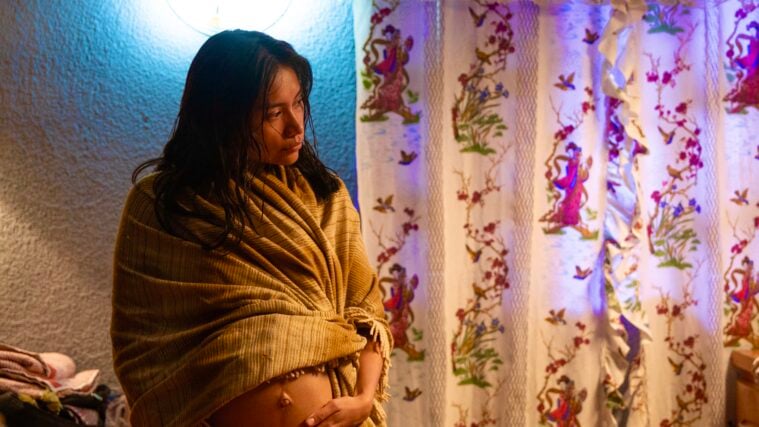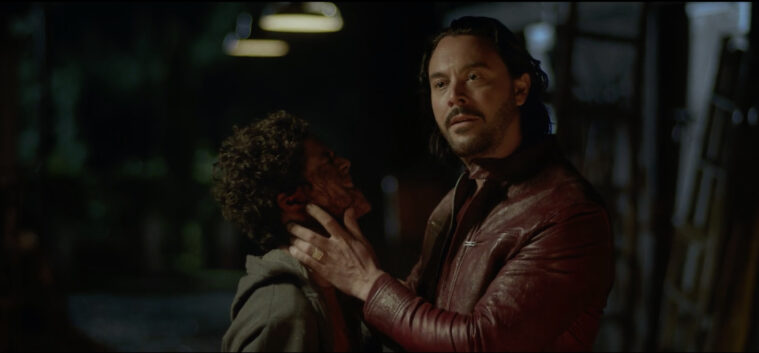This is part of our coverage of South by South West (SXSW) 2023.
Baal was once known as the king of gods. The ancient Canaanites called him the “Lord of Rain and Dew.” The Phoenicians, the “Lord of the Heavens.” The Israelites named him “He Who Rides the Clouds.” It was only after the Hebrew queen Jezebel tried to replace the official worship of the Hebrew God with the worship of Baal in the ninth century BCE that Baal became the emblem for a false god, a fallen angel, and later, the prince of demons himself: Satan.
But in the supernatural thriller Hail Mary, directed by Rosemary Rodriguez and written by Knate Lee, Baal (Jack Huston) arrives in Central America as the devil’s servant incarnate. While all powerful, he lacks autonomy. And he’s on his master’s mission to hunt down Maria (Natalia del Riego) before she makes her way from Belize to the United States to give birth to an infant who will someday save the world.

Audiences will recognize the plot when Maria suddenly experiences immaculate conception. But the Herod virus, which has killed all newborns in Central America, forces her to make her way north to the United States, the only safe place to give birth. To make things worse, the United States has closed its borders to pregnant women fleeing the crisis, terrorizing and separating families who attempt to cross the border. It’s only with the angel Gabrielle’s (Angela Sarafyn) intervention and carpenter Jose’s (Benny Emmanuel) help that Maria stands a chance to escape Baal and make it through the tunnels under the Rio Grande.
On the trek north, the vibrant green sugarcane fields of Belize turn into the sprawling metropolis of Mexico City, and then the mountains of Nuevo Laredo. Crosses dot the landscape, but God is hard to find. Baal acts as a reverse Jesus in a land desperate for deliverance from cartels and corruption. Whereas Jesus laid his hands on the sick to heal, Baal’s touch takes away the lives of those he meets. Whereas Jesus gave sight to the blind, Baal makes blind those with sight.
At first, Baal scoffs at the limitations of human mortality and our proclivity toward pain and disease. But then Baal’s curiosity leads him to question what it is like to be human. In doing so, he seems more human than the other characters in the film, who seem like static tropes by comparison—like Maria who follows divine providence to serve as a vessel for her baby savior or the fair-skinned, blue-eyed white angel Gabrielle who aids migrants through prayer from her gated mansion in Texas’ Hill Country.
In what turns out to be a parallel quest to comprehend what it means to be human, Baal tastes his own blood, tries tacos al pastor, and snacks on Slim Jims. He kisses a woman he meets for the first time, asking her, “Is that love?” to which she replies, “No lo creo [I don’t think so].” He tries to imagine Jose’s love for Maria and expresses disappointment when Jose vacillates between self-preservation and self-sacrifice for the virgin madonna.
Along the way, Baal becomes the moral lens through which the audience sees the heinous acts of U.S. immigration authorities. While Baal hunts down Maria and child on the devil’s command, he reminds the border agents that they “hunt humans” of their own volition.

“I am what I am,” Baal says, apologizing. But to those he meets, he says, “You were given free will and self-determination.” Free will, as the angel Gabrielle reminds Maria, to choose between “on one side the devil, and on the other your child.”
So in this pointed and sometimes belabored challenge to Americans, Hail Mary asks us which we will choose—to accept our neighbors or turn them away in a time of crisis. What we choose may either save or damn this country’s soul.







